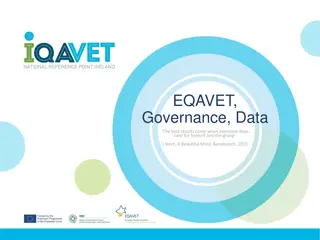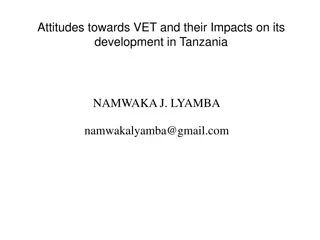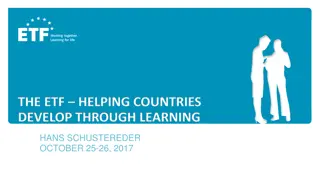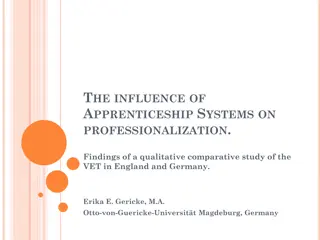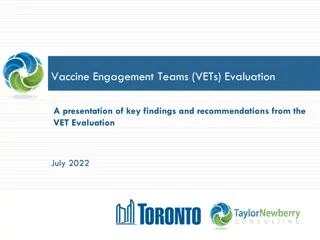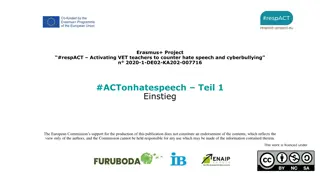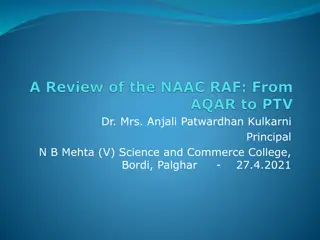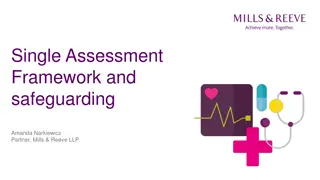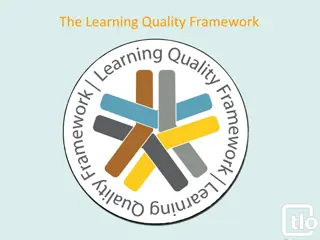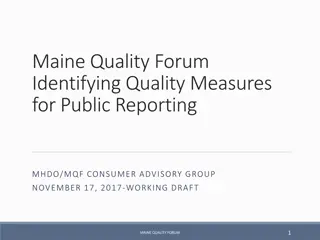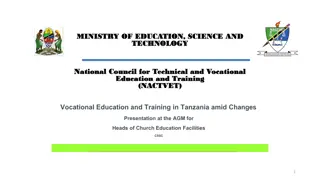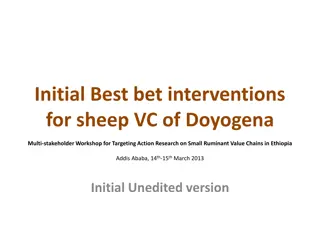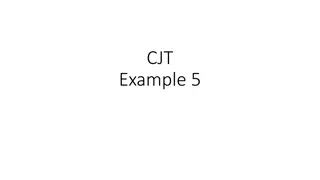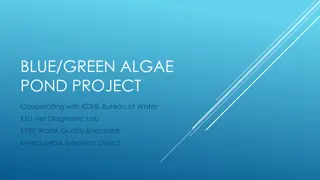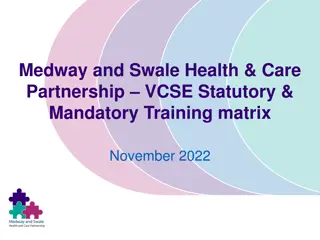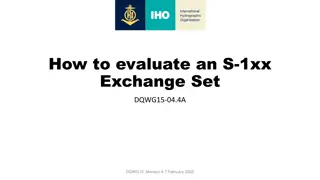The EQAVET Framework: Supporting Quality and Relevance of VET
The EQAVET Framework plays a crucial role in improving the implementation of Quality Assurance in VET across EU countries. It serves as a catalyst for reform and promotes the modernization of education systems by enhancing the effectiveness of training. Challenges faced by Member States, EU cooperation in VET, and the importance of quality assurance in VET are highlighted. EQAVET is a valuable QA management tool designed to enhance VET systems and ensure responsiveness to societal needs and inclusion.
Uploaded on Sep 29, 2024 | 0 Views
Download Presentation

Please find below an Image/Link to download the presentation.
The content on the website is provided AS IS for your information and personal use only. It may not be sold, licensed, or shared on other websites without obtaining consent from the author. Download presentation by click this link. If you encounter any issues during the download, it is possible that the publisher has removed the file from their server.
E N D
Presentation Transcript
The EQAVET Framework supporting quality and relevance of VET Arancha Oviedo, EQAVET Secretariat Dublin, IQAVET Conference 8 March 2017
Added-value of EQAVET EQAVET helped to improve the implementation of QA in EU countries; and served as a catalyst for reform The choice of the Recommendation as legal basis was a good one; the work at European level as well as in MS has speeded up since the adoption of the Recommendation The material developed at European level is felt to be user friendly and useful but difficult to disseminate at national level because of need of adaptation NRPs, key role need to be appropriately resourced EQAVET is consistent and complementary to the other tools (ECVET, EQF) but does not cover certain aspects dealt with by ECVET and EQF (e.g. qualification design, certification process)
Challenges faced by Member States Evolving labour market Social context for VET Migration Skills obsolescence and mismatch System-driven approaches New forms of learning and course delivery
EU cooperation in VET Copenhagen Process Bruges Communiqu 2010 and its short term deliverables 2010-20 Riga Conclusions 2015 reduced set of sort term deliverables for 2015-20 New Skills Agenda June 2016 focus on employability
Why quality assurance of VET? Increase transparency & mobility More efficient VET, adapted to the labour market More attractive VET in the continuum of LLL and progression pathways More effective and better VET Responsiveness to societal needs and social inclusion Education and Training policy context Mutual learning and consensus building Tools to support QA at national/regional levels Common principles, reference criteria and instruments European cooperation in VET
The EQAVET Framework QA management tool Designed to promote better VET A reference instrument to help authorities of MS and providers to evaluate and improve; and promote and monitor the improvement of their VET systems Uses QA as a systematic approach to modernising education systems, especially by improving the effectiveness of training MS and providers are invited to develop/use this instrument on a voluntary basis. Main users are national/regional authorities, VET providers, public /private bodies responsible for ensuring and improving the quality of VET Complements the work of EQF and ECVET
Short term deliverables for VET Bruges Communiqu and short term deliverables 2010-2015 related to EQAVET Participating countries were invited to establish at national level a: Riga Conclusions and short term deliverables 2015-2020 1. 2. Promote WBL in all its forms Further develop QA mechanisms in VET in line with the EQAVET, and establish continuous information and feedback loops in IVET and CVET based on LO Enhance access to VET and qualifications for all through more flexible and permeable systems Further strengthen key competences in VET curricula Introduce systematic approaches and opportunities for initial and continuous professional development of VET teachers, trainers and mentors in both school and WBL settings - QA frameworks in accordance with the EQAVET Recommendation by 2013; 3. - Common QA framework for VET providers compatible with the EQAVET framework which also applies to WBL by 2015 4. 5.
EQAVET indicators used at system level for the IVET and CVET sectors IVET CVET 90% 84% 81% 80% 69% 70% 63% 63% 63% 63% 59% 56% 60% 63% 56% 50% 53% 53% 50% 44% 50% 38% 47% 41% 38% 40% 41% 31% 31% 30% 28% 25% 22% 28% 19% 19% 22% 22% 19% 16% 20% 13% 10% 0% INDICATOR 3 INDICATOR 4 INDICATOR 7 INDICATOR 1A INDICATOR 1B INDICATOR 2A INDICATOR 2B INDICATOR 5A INDICATOR 5B INDICATOR 6A INDICATOR 6B INDICATOR 8A INDICATOR 8B INDICATOR 9A INDICATOR 9B INDICATOR 10A INDICATOR 10B
A culture of QA shared by all stakeholders Underpinning an evidence-based and outcomes focused approach to QA in VET Support continued improvement VET adheres to principles of access and equity and maximizes outcomes Respond to the need of the labour market and society
EQAVET work in key areas VET in employment supporting QA in WBL and CVET Supporting an evaluation and quality improvement culture EQAVET Indicators improving the labour market relevance of VET systems - Symposium on learning from sectoral approach to QA of VET PLAs and Policy brief on Self-evaluation for VET providers; the impact of QA systems in IVET systems; and on Early warning system, averting drop-outs, supporting providers to implement improvement - Building blocks on quality assuring WBL PLAs and Policy briefs on EQAVET indicator 5, 6, 9 and 2 - Supporting AL, CVET and soft skills development by using quality assurance descriptors and indicators Supporting learning outcomes a partnership approach Support to National Reference Points and EQAVET Forum as part of EU VET week -Information Gathering Exercise on QA procedures in the processes of certification, curricula setting, accreditation and training of trainers Activities to support VET providers identify key features of their own approach to QA through self-reflection; utilising the EQAVET IT tool for systems and providers (case studies and a glossary of terms) -Using ECVET and EQAVET principles: some early experiences at national level - Joint activities EQAVET, ECVET, EQF; and with HE Increase visibility
Work on Complementing EQAVET, work in 2017 and beyond 1. Apprenticeship/work-based learning provision and in- company training; 2. the processes of defining, describing and assessing learning outcomes; 3. qualification design, assessment and certification; 4. the pedagogical processes associated with learning outcomes; 5. the teachers and trainers role in the quality assurance process; 6. procedures which are used in the validation of non-formal and informal learning in line with EQF/NQFs; 7. planning and improving the review phase of the quality assurance cycle.
Guidelines to support VET systems and providers
Guidelines to support VET systems and providers
Thank you! www.eqavet.eu


